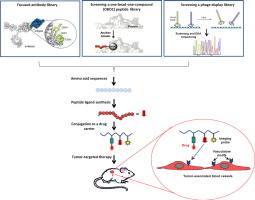Advanced Drug Delivery Reviews ( IF 15.2 ) Pub Date : 2017-05-12 , DOI: 10.1016/j.addr.2017.05.006 Ayelet David

|
Since their initial discovery more than 30 years ago, tumor-homing peptides have become an increasingly useful tool for targeted delivery of therapeutic and diagnostic agents into tumors. Today, it is well accepted that cells at the tumor microenvironment (TME) contribute in many ways to cancer development and progression. Tumor-homing peptide-decorated nanomedicines can interact specifically with surface receptors expressed on cells in the TME, improve cellular uptake of nanomedicines by target cells, and impair tumor growth and progression. Moreover, peptide ligand-modified nanomedicines can potentially accumulate in the target tissue at higher concentrations than would small conjugates, thus increasing overall target tissue exposure to the therapeutic agent, enhance therapeutic efficacy and reduce side effects. This review describes the most studied peptide ligands aimed at targeting cells in the TME, discusses major obstacles and principles in the design of ligands for drug targeting and provides an overview of homing peptides in ligand-targeted nanomedicines that are currently in development for cancer therapy and diagnosis.
中文翻译:

肽配体修饰的纳米药物,用于靶向肿瘤微环境中的细胞
自30多年来首次发现以来,肿瘤归巢肽已成为将治疗剂和诊断剂靶向递送到肿瘤中的越来越有用的工具。如今,众所周知的是,肿瘤微环境(TME)处的细胞以多种方式参与了癌症的发展和进程。装饰有肿瘤归巢肽的纳米药物可以与TME中细胞表达的表面受体特异性相互作用,改善靶细胞对纳米药物的细胞吸收,并损害肿瘤的生长和发展。此外,肽配体修饰的纳米药物可能以比小缀合物更高的浓度在靶组织中蓄积,因此增加了靶组织对治疗剂的总体暴露,增强了治疗功效并减少了副作用。











































 京公网安备 11010802027423号
京公网安备 11010802027423号